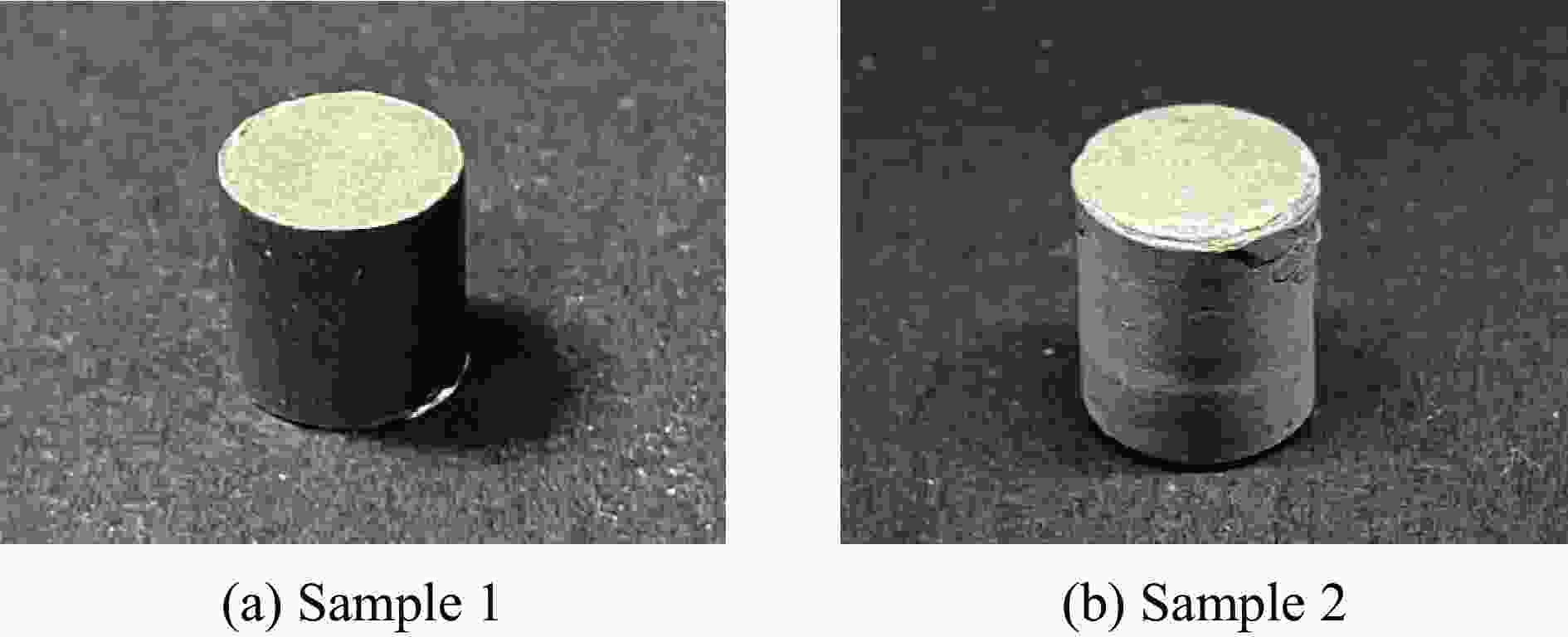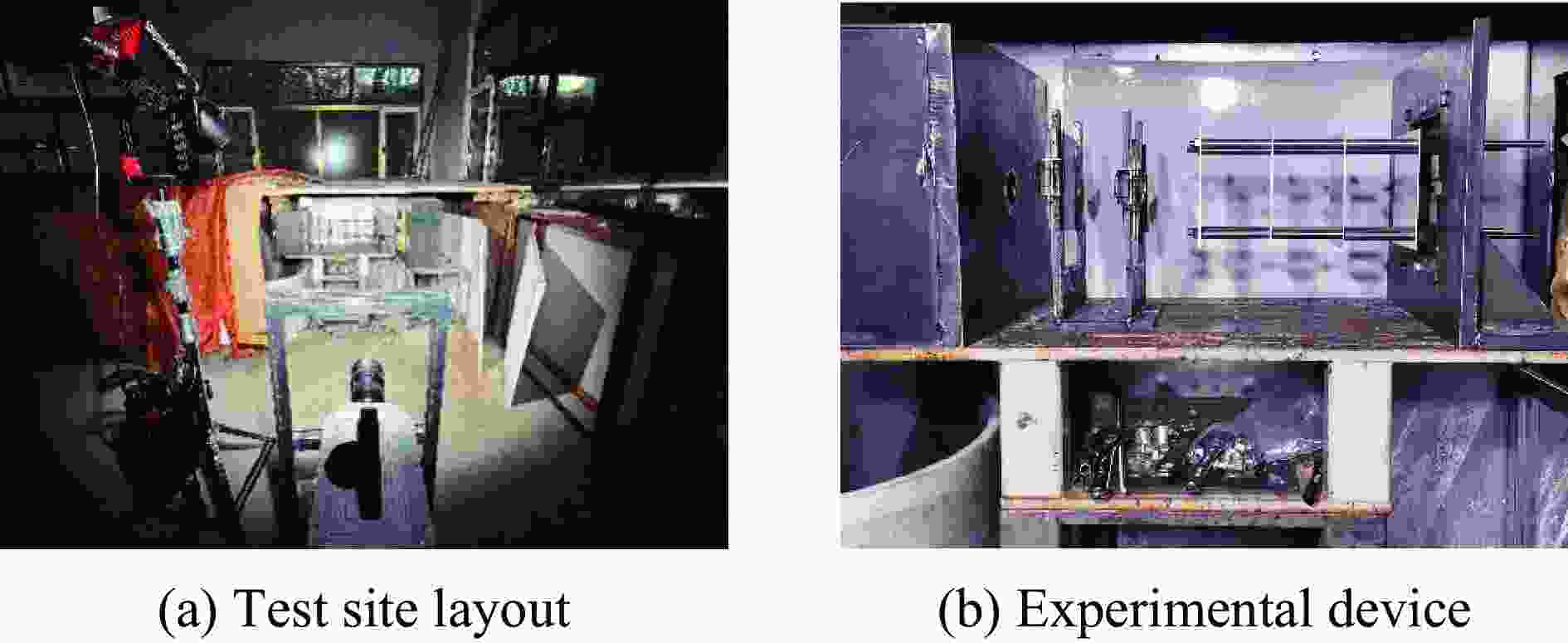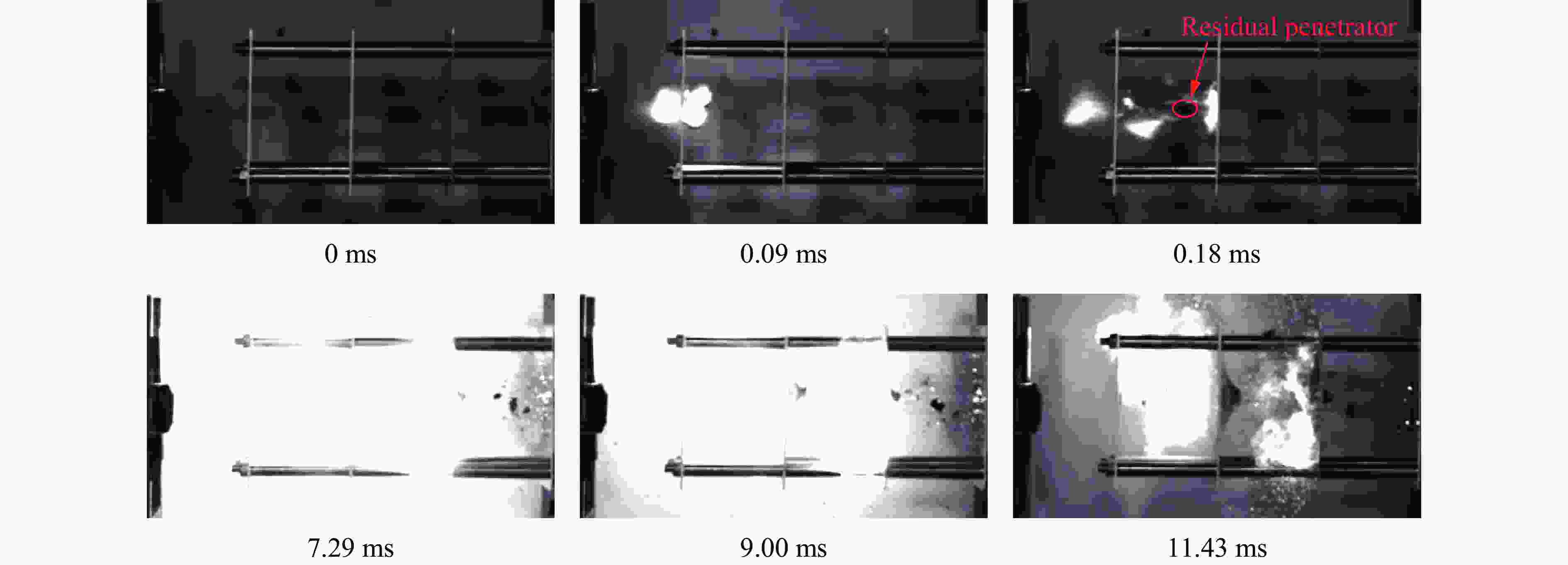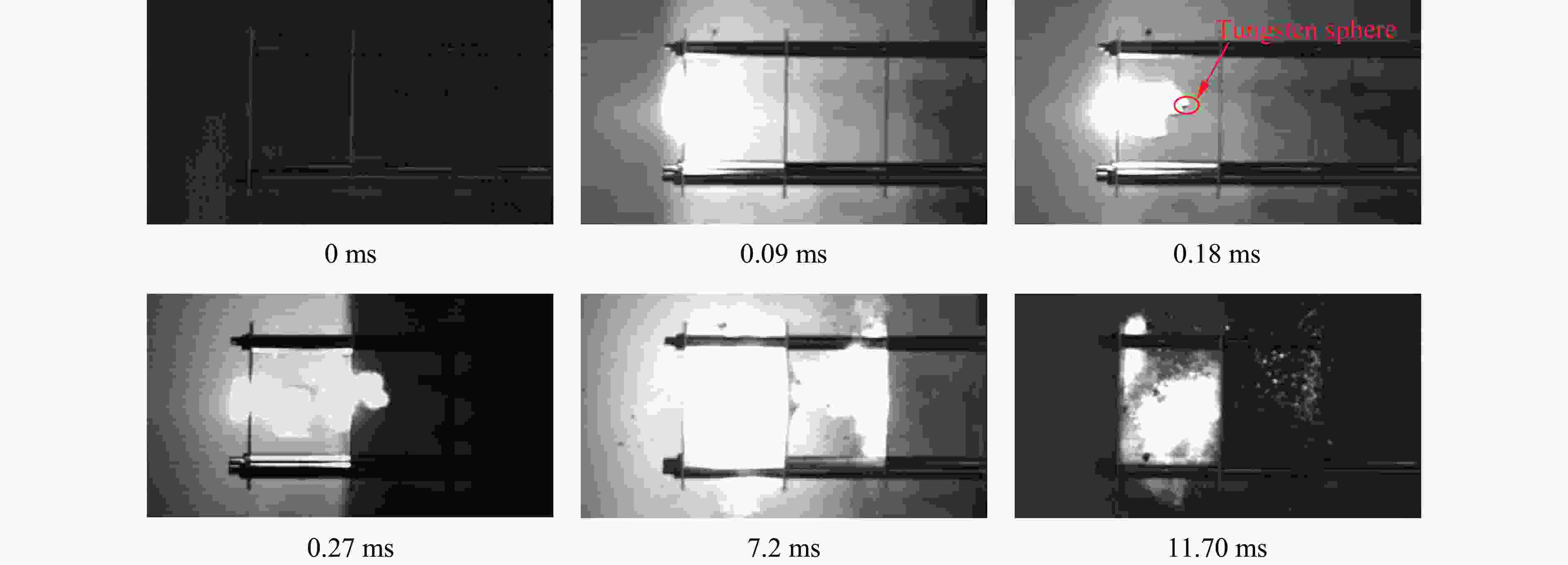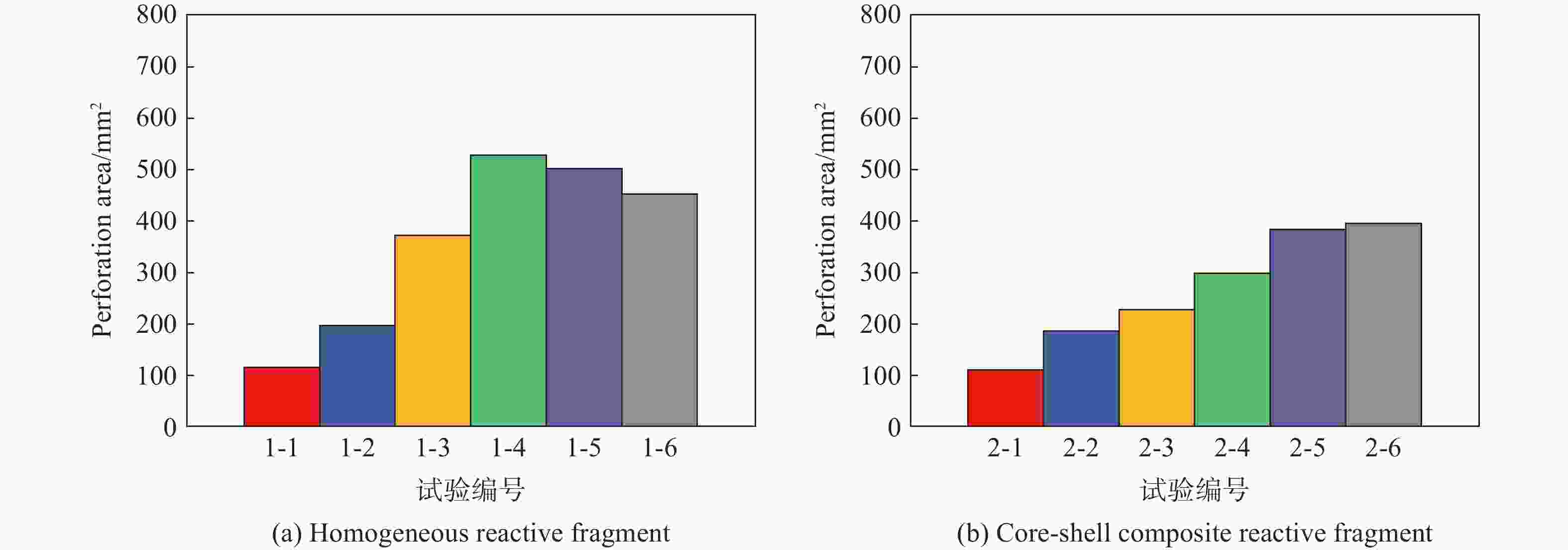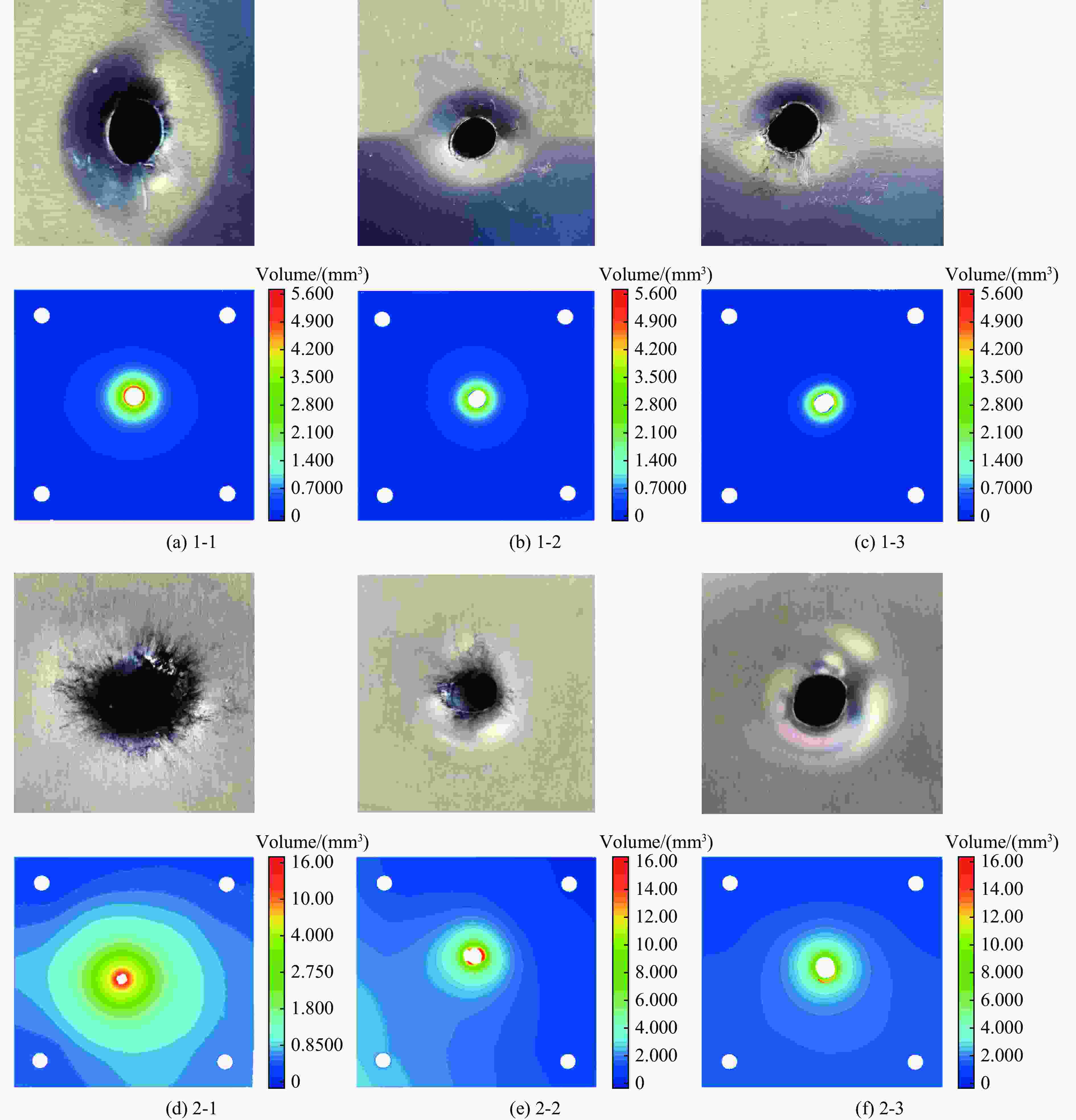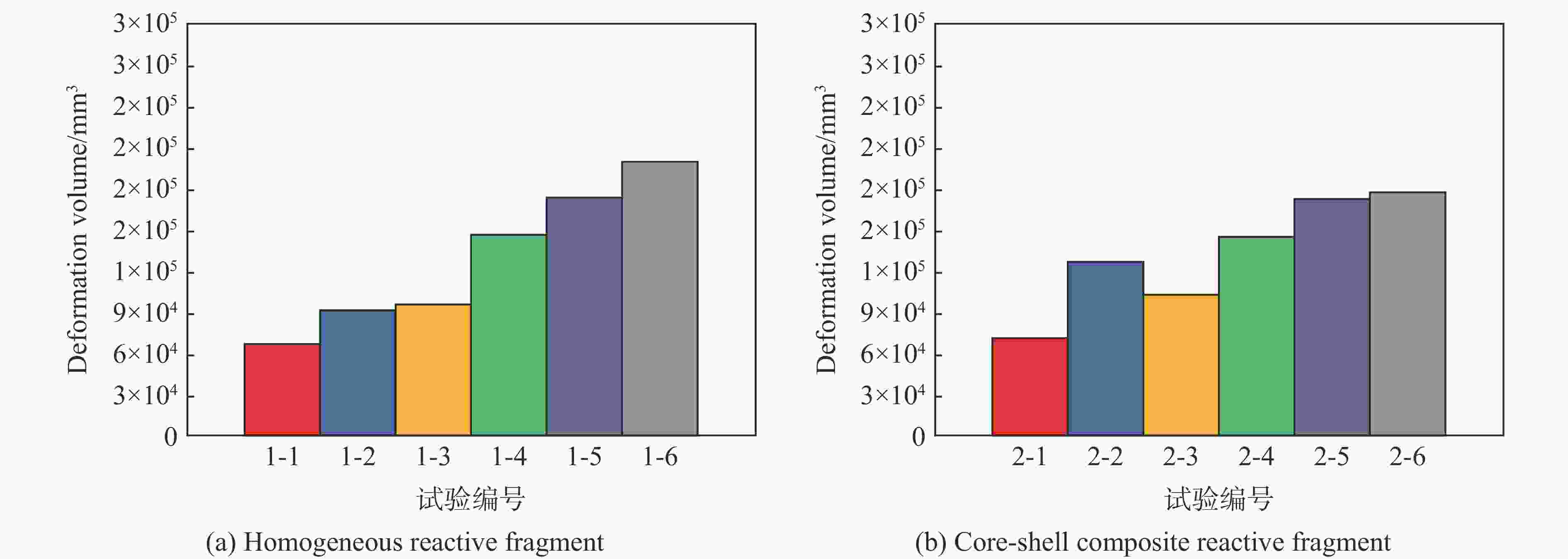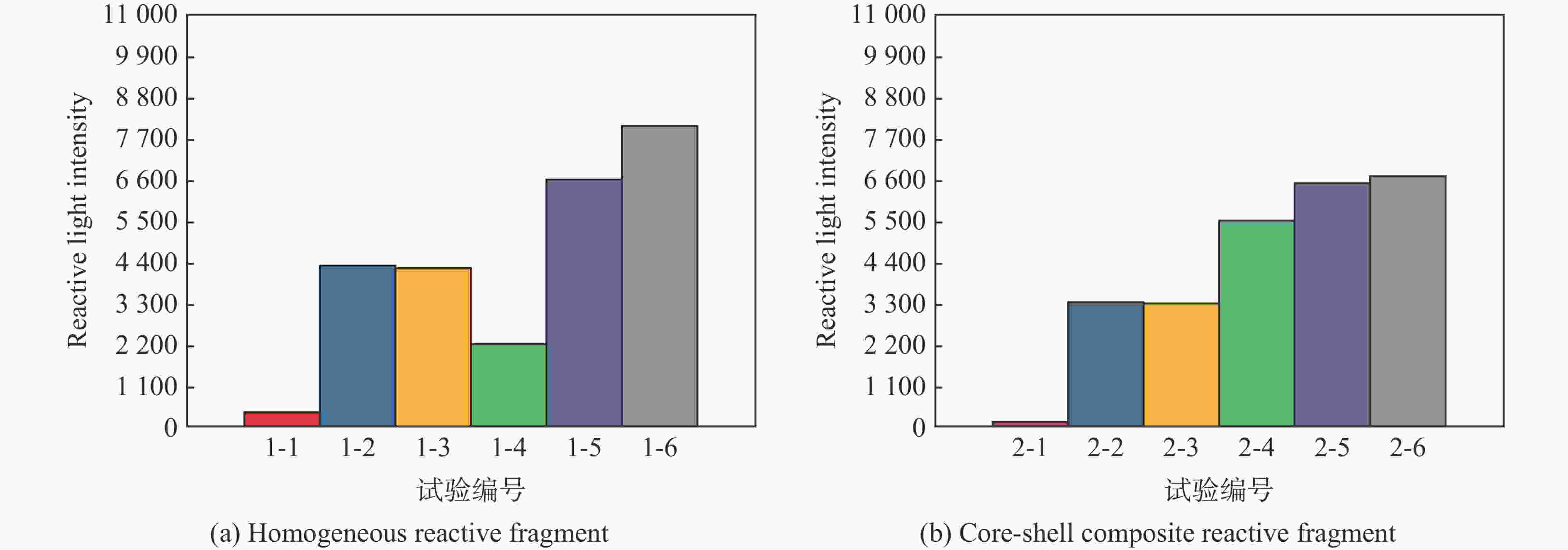Study on the damage effect of core-shell composite reactive fragments on spaced targets
-
摘要: 为提升氟聚物基活性破片的毁伤效率,拓展其应用范围,研制了一种“核壳”式复合结构活性破片,该破片采用湿混法,引入碳纤维增强基体材料的强度,采用特定的烧结条件,制备了PTFE/Al/CF钨粉和PTFE/Al/CF钨球2种试样,并开展了相应的基本力学性能试验。通过2种结构破片侵彻3 mm+3 mm+2 mm+2 mm多层间隔铝靶试验,采用Python自编的源程序对试验数据进行自动处理,获得了各层靶板的穿孔面积、变形体积以及反应光强总量,对比分析了不同速度和约束条件下多层间隔靶的毁伤特征差异。研究结果表明:“核壳”式破片侵彻能力更强,低速可穿透4层靶板,但穿孔面积较小,穿孔直径约为0.95倍破片直径;均质破片穿孔面积更大,但侵彻能力较弱,穿孔直径约为1.21倍破片直径,高速条件下只能穿透3层靶板;钢壳约束显著提升了破片的穿孔和侵彻能力。破片的主要活性反应发生在与第2层靶的撞击过程中,但其释能反应对穿孔效应的促进作用有限,毁伤特征差异主要取决于破片的力学特性。Abstract: To enhance the damage efficiency of fluoropolymer-based reactive fragments and broaden their application range, a novel core-shell composite structure active fragment has been proposed. To improve the strength of the matrix material, carbon fiber was introduced via a wet mixing method. Under specific sintering conditions, two types of samples were prepared: PTFE/Al/CF tungsten powder and PTFE/Al/CF tungsten ball. The basic mechanical properties of these samples were tested. The addition of tungsten powder was found to increase the dynamic compressive strength of the composite. Penetration tests were conducted on 3 mm+3 mm+2 mm+2 mm multi-layer interval aluminum targets using both types of fragments. The experimental data were automatically processed using a Python-based program, yielding the perforation area, deformation volume, and reaction light intensity for each layer of the target plate. The damage characteristics of the multi-interval target under different velocity and constraint conditions were compared and analyzed. The results show that the core-shell type fragment exhibits superior penetration ability. It can penetrate all four layers of the target plates at low speeds, although the perforation area is relatively small, with a perforation diameter approximately 0.95 times the fragment diameter. In contrast, the homogeneous fragment has a larger perforation area but weaker penetration ability. Its perforation diameter is about 1.21 times the fragment diameter, and it can only penetrate three layers of target plates at high speeds. The steel shell constraint significantly enhances the punching and penetration capabilities of the fragments. The primary active reaction of the fragment occurs during impact with the second layer of the target. The energy release reaction has a limited effect on improving the punching effect. The differences in damage characteristics are mainly attributed to the mechanical properties of the fragments. These findings provide valuable insights for the structural design and damage effect evaluation of reactive fragments.
-
表 1 活性材料试样的基体材料质量配比
Table 1. Formulation of the matrix materialfor the reactive material test sample
w(PTFE)/% w(Al)/% w(CF)/% 理论最大密度/(g·cm−3) 72.0 26.0 2 2.270 表 2 试样2的质量配比
Table 2. Formulation of sample 2
配方 w(PTFE)/% w(Al)/% w(CF)/% w(W)/% 试样 30.1 10.9 2 57 表 3 2种材料的动态力学性能参数
Table 3. Dynamic mechanical properties of two materials
试样 气室气压/
MPa应变率/
s−1屈服强度/
MPa弹性模量/
MPa抗压强度/
MPaPTFE/Al/CF 0.04 682 18.7 849 25.0 0.10 2304 29.1 963 44.8 0.15 3007 37.5 1202 52.1 0.20 5448 48.8 1260 55.8 PTFE/Al/CF/W 0.05 970 31.9 1611 37.2 0.10 2378 38.9 2288 53.2 0.15 3217 45.1 2791 56.5 0.20 5386 52.6 2810 63.5 表 4 侵彻毁伤试验设计
Table 4. Design of penetration and damage tests
破片类型 有无约束 试验编号 质量/g 破片直径/mm 破片长度/mm 气室压力/MPa 速度/(m·s−1) PTFE/Al/CF/钨粉 无 1-1 3.60 10.02 10.04 3.0 549 1-2 3.61 10.02 10.03 5.5 606 1-3 3.55 10.02 10.02 8.0 759 有 1-4 5.24 11.10 10.03 3.0 538 1-5 5.22 11.10 10.03 5.5 673 1-6 5.18 11.10 10.01 8.0 725 PTFE/Al/CF/钨球 无 2-1 3.59 10.02 10.04 3.0 533 2-2 3.61 10.04 10.02 5.5 673 2-3 3.56 10.02 10.00 8.0 736 有 2-4 5.20 11.10 10.50 3.0 565 2-5 5.22 11.10 10.50 5.5 653 2-6 5.21 11.10 10.50 8.0 745 表 5 各工况对应的各层靶板的穿孔面积
Table 5. Perforated area of each layer of the target plate for each operating condition
试验编号 速度/(m·s−1) 各层靶板穿孔面积/mm2 总穿孔面积/mm2 第1层 第2层 第3层 第4层 1-1 549 116.06 0 0 0 116.06 1-2 606 116.18 79.76 0 0 195.94 1-3 759 132.82 128.32 110.86 0 372.00 1-4 538 159.99 366.57 0 0 526.56 1-5 673 148.66 330.38 22.43 0 501.47 1-6 725 170.16 202.30 80.46 0 452.92 2-1 533 39.42 22.77 24.16 24.85 111.20 2-2 673 111.21 25.55 24.16 24.51 185.43 2-3 736 157.22 25.09 22.08 22.89 227.28 2-4 565 138.60 111.09 24.04 23.81 297.54 2-5 653 155.71 176.64 25.32 24.04 381.71 2-6 745 140.45 206.46 20.00 26.24 393.15 表 6 各工况变形靶板的变形体积
Table 6. The deformation volume of the deformed target plate under various working conditions
试验编号 速度/(m·s−1) 各层靶板变形体积Vd/mm3 总变形体积Vt/mm3 第1层 第2层 第3层 第4层 1-1 549 11845 55840 − − 67685 1-2 606 11433 53539 27499 − 92471 1-3 759 6655 29797 35855 23655 95962 1-4 538 11387 98668 36862 − 146917 1-5 673 6990 87570 74165 5000 173725 1-6 725 7455 107958 62652 21882 199947 2-1 533 30809 11968 11477 15603 69857 2-2 673 51321 28440 27452 18495 125708 2-3 736 47834 28047 14814 10555 101250 2-4 565 36352 57151 32070 18638 144211 2-5 653 23198 102155 34736 10826 170915 2-6 745 35591 81511 47527 10635 175264 表 7 各工况下变形靶板前的亮度积分结果
Table 7. The brightness integral results before the deformation target plate under various working conditions
试验编号 速度/(m·s−1) 各层靶板前的亮度积分 总亮度积分 第1层 第2层 第3层 第4层 1-1 549 140.06 247.09 − − 387.15 1-2 606 1103.80 2322.21 856.01 − 4282.02 1-3 759 948.40 1402.60 1035.30 845.70 4232.00 1-4 538 468.10 861.50 862.90 − 2192.50 1-5 673 1451.60 2939.20 2189.90 1149.80 7730.50 1-6 725 1852.10 2468.10 2148.40 1538.00 8006.60 2-1 533 18.45 71.40 31.80 7.80 129.45 2-2 673 919.20 1244.40 784.80 367.80 3316.20 2-3 736 841.80 1136.70 768.50 548.20 3295.20 2-4 565 1256.50 1873.40 1419.90 956.40 5506.20 2-5 653 1393.10 2621.70 1507.50 981.40 6503.70 2-6 745 1571.00 2022.60 1797.60 1271.20 6662.40 -
[1] 李向东, 杜忠华. 目标易损性 [M]. 北京: 北京理工大学出版社, 2013.LI X D, DU Z H. Target Vulnerability [M]. Beijing: Beijing Institute of Technology Press, 2013. [2] 叶文君, 汪涛, 鱼银虎. 氟聚物基含能反应材料研究进展 [J]. 宇航材料工艺, 2012, 42(6): 19–23. DOI: 10.3969/j.issn.1007-2330.2012.06.003.YE W J, WANG T, YU Y H. Research progress of fluoropolymer-matrix energetic reactive materials [J]. Aerospace Materials & Technology, 2012, 42(6): 19–23. DOI: 10.3969/j.issn.1007-2330.2012.06.003. [3] WADDELL J T, BOOTES T H, BUDY G D, et al. Reactive shaped charge, reactive liner, and method for target penetration using a reactive shaped charge: US 2011/0239888 A1 [P]. 2011-10-18. [4] 沈波, 李延. 全含能侵彻战斗部对多层钢介质的毁伤威力表征技术 [J]. 含能材料, 2021, 29(2): 141–148. DOI: 10.11943/CJEM2020256.SHEN B, LI Y. Characterization technology of damage power of all-energetic penetrating warhead to multilayer steel medium [J]. Chinese Journal of Energetic Materials, 2021, 29(2): 141–148. DOI: 10.11943/CJEM2020256. [5] 王靖岩, 王义智, 韩志伟. 铝-氟聚物反应性物质制备及研究进展 [J]. 含能材料, 2021, 29(1): 78–86. DOI: 10.11943/CJEM2020113.WANG J Y, WANG Y Z, HAN Z W. Preparation and research progress of aluminum-fluoropolymer reactive materials [J]. Chinese Journal of Energetic Materials, 2021, 29(1): 78–86. DOI: 10.11943/CJEM2020113. [6] 黄亨建, 黄辉, 阳世清, 等. 毁伤增强型破片探索研究 [J]. 含能材料, 2007, 15(6): 566–569. DOI: 10.3969/j.issn.1006-9941.2007.06.002.HUANG H J, HUANG H, YANG S Q, et al. Preliminary research on damage enhanced fragment [J]. Chinese Journal of Energetic Materials, 2007, 15(6): 566–569. DOI: 10.3969/j.issn.1006-9941.2007.06.002. [7] 郑雄伟, 袁宝慧, 陈进, 等. Al-PTFE 活性材料的冲击压力对冲击释能规律影响研究 [J]. 兵器材料科学与工程, 2016, 39(3): 110–113. DOI: 10.14024/j.cnki.1004-244x.20160421.002.ZHENG X W, YUAN B H, CHEN J, et al. Effect of shock pressure on energy releasing characteristic of Al-PTFE reactive materials [J]. Ordnance Material Science and Engineering, 2016, 39(3): 110–113. DOI: 10.14024/j.cnki.1004-244x.20160421.002. [8] 肖艳文, 徐峰悦, 余庆波, 等. 高密度活性破片碰撞双层靶毁伤效应 [J]. 科技导报, 2017, 35(10): 99–103. DOI: 10.3981/j.issn.1000-7857.2017.10.014.XIAO Y W, XU F Y, YU Q B, et al. Damage of double-spaced plates by reactive material fragment impact [J]. Science & Technology Review, 2017, 35(10): 99–103. DOI: 10.3981/j.issn.1000-7857.2017.10.014. [9] WANG H F, XIE J W, GE C, et al. Experimental investigation on enhanced damage to fuel tanks by reactive projectiles impact [J]. Defence Technology, 2021, 17(2): 599–608. DOI: 10.1016/j.dt.2020.03.01. [10] 彭军, 李彪彪, 袁宝慧, 等. 钢包覆式活性破片侵彻双层铝靶的行为特性研究 [J]. 火炸药学报, 2020, 43(1): 90–95. DOI: 10.14077/j.issn.1007-7812.201911013.PENG J, LI B B, YUAN B H, et al. Research on behavior of steel-coated reactive materials fragment on penetrating double-layer aluminum plates [J]. Chinese Journal of Explosives & Propellants, 2020, 43(1): 90–95. DOI: 10.14077/j.issn.1007-7812.201911013. [11] YUAN Y, LIU Z Y, HE S, et al. Shock-induced reaction behaviors of functionally graded reactive material [J]. Defence Technology, 2021, 17(5): 1687–1698. DOI: 10.1016/j.dt.2020.09.010. [12] ZHANG H, WANG H F, YU Q B, et al. Perforation of double-spaced aluminum plates by reactive projectiles with different densities [J]. Materials, 2021, 14(5): 1229. DOI: 10.3390/ma14051229. [13] 王在成, 徐祎, 姜春兰, 等. 钨锆钛活性破片对间隔靶的毁伤效应 [J]. 兵工学报, 2023, 44(12): 3862–3871. DOI: 10.12382/bgxb.2023.0289.WANG Z C, XU Y, JIANG C L, et al. Damage effect of W/Zr/Ti reactive fragments on spaced targets [J]. Acta Armamentarii, 2023, 44(12): 3862–3871. DOI: 10.12382/bgxb.2023.0289. [14] 曹进, 陈春林, 马坤, 等. 球形含能结构材料弹体超高速撞击多层薄钢靶的毁伤特性 [J]. 含能材料, 2023, 31(8): 786–796. DOI: 10.11943/CJEM2023131.CAO J, CHEN C L, MA K, et al. Investigation on damage characteristics of multilayer thin steel target penetrated by hypervelocity spherical reactive materials projectile [J]. Chinese Journal of Energetic Materials, 2023, 31(8): 786–796. DOI: 10.11943/CJEM2023131. [15] 任鑫鑫, 李裕春, 吴家祥, 等. 碳纤维对PTFE/Al 反应材料动态力学行为和点火特性影响研究 [J]. 北京理工大学学报, 2023, 43(10): 1026–1035. DOI: 10.15918/j.tbit1001-0645.2023.047.REN X X, LI Y C, WU J X, et al. Effect of carbon fiber on dynamic mechanical behavior and ignition characteristics of PTFE/Al reactive materials [J]. Transactions of Beijing institute of Technology, 2023, 43(10): 1026–1035. DOI: 10.15918/j.tbit1001-0645.2023.047. [16] 丁亮亮. PELE 弹活性内芯配方与弹体结构设计及毁伤机理研究 [D]. 长沙: 国防科技大学, 2019. DOI: 10.27052/d.cnki.gzjgu.2019.000303.DING L L. Research on the reactive inner core formulation and structural design as well as damage mechanism of PELE projectile [D]. Changsha: National University of Defense Technology, 2019. DOI: 10.27052/d.cnki.gzjgu.2019.000303. [17] SI S P, HE C, LIU S, et al. Influence of impact velocity on impact-initiated reaction behavior of Zr-Ti-Nb alloy [J]. Materials & Design, 2022, 220: 110846. DOI: 10.1016/j.matdes.2022.110846. -







 下载:
下载:
